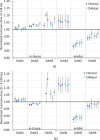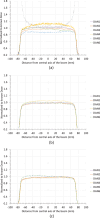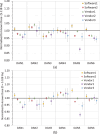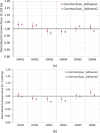An international film dosimetry intercomparison to establish a multi-center audit framework
- PMID: 39316455
- PMCID: PMC11656281
- DOI: 10.1002/mp.17428
An international film dosimetry intercomparison to establish a multi-center audit framework
Abstract
Background: In 2021, a Technical Meeting was hosted by the International Atomic Energy Agency (IAEA) where it was recommended that a standardized method for assessing the accuracy of film dose calculations should be established.
Purpose: To design an audit that evaluates the accuracy of film dosimetry processes. To propose a framework for identifying out-of-tolerance results and to perform an international pilot study to test the audit design.
Methods: Six members of an international Dosimetry Audit Network (DAN) developed an audit for radiochromic film dosimetry. A single host center provided the materials to each participating DAN member to conduct the audits. Materials included: (1) a set of two irradiated audit films (10 Sq: 10 cm × 10 cm, 15 Sq: 15 cm × 15 cm), (2) a reference calibration film set, and (3) a blank sheet of film. The participants were blinded to the dose and tasked with producing dose maps using their standard film dosimetry process. Average Region-Of-Interest (ROI: 2 cm × 2 cm) dose was measured from the dose maps and compared to the known dose. In the audit, all participants used their local scanning and software protocols. Film calibration was performed in two distinct ways: (1) using a calibration film set which was provided by the host center and (2) using a calibration film set which was locally irradiated. Several variations of the audit were also performed to examine how scanning and software processing can affect film dosimetry results. In the first variation of the audit (VariantA), a set of film scans was processed using five different software solutions. In the second variation of the audit (VariantB), all films were scanned on the same scanner and processed using two in-house software solutions.
Results: Taking one film scan from each participant, the standard deviations (1σ) (SD) in the dose returned from the host calibration and returned from the local calibration were ±7.2% and ±6.5% respectively, with variations from -12.4% to 12.9% of the known dose. The larger dose variations in the data set were attributed to the corrections applied for variations in scanner brightness during processing and incorrectly assigned calibration doses. When the raw image data set was processed by an expert user of each software solution (VariantA) the SDs were ±2.7% and ±3.7% for in-house and vendor-based software, respectively. When the films were scanned on a single scanner and processed with the two in-house software solutions (VariantB) the results had a SD of ±2.3%.
Conclusions: An audit has been designed and tested for radiotherapy film dosimetry at an international level. A framework for diagnosing issues within a film dosimetry process has been proposed that could be used to audit centers that use film as a dosimeter. Incorporating quality assurance throughout the film process is important in obtaining accurate and consistent film dosimetry. A better understanding of vendor-based software systems is necessary for users to process accurate and consistent film dosimetry.
Keywords: audit; film dosimetry; quality assurance.
© 2024 The Author(s). Medical Physics published by Wiley Periodicals LLC on behalf of American Association of Physicists in Medicine.
Conflict of interest statement
The authors declare no conflicts of interest.
Figures









References
Publication types
MeSH terms
LinkOut - more resources
Full Text Sources
Miscellaneous

